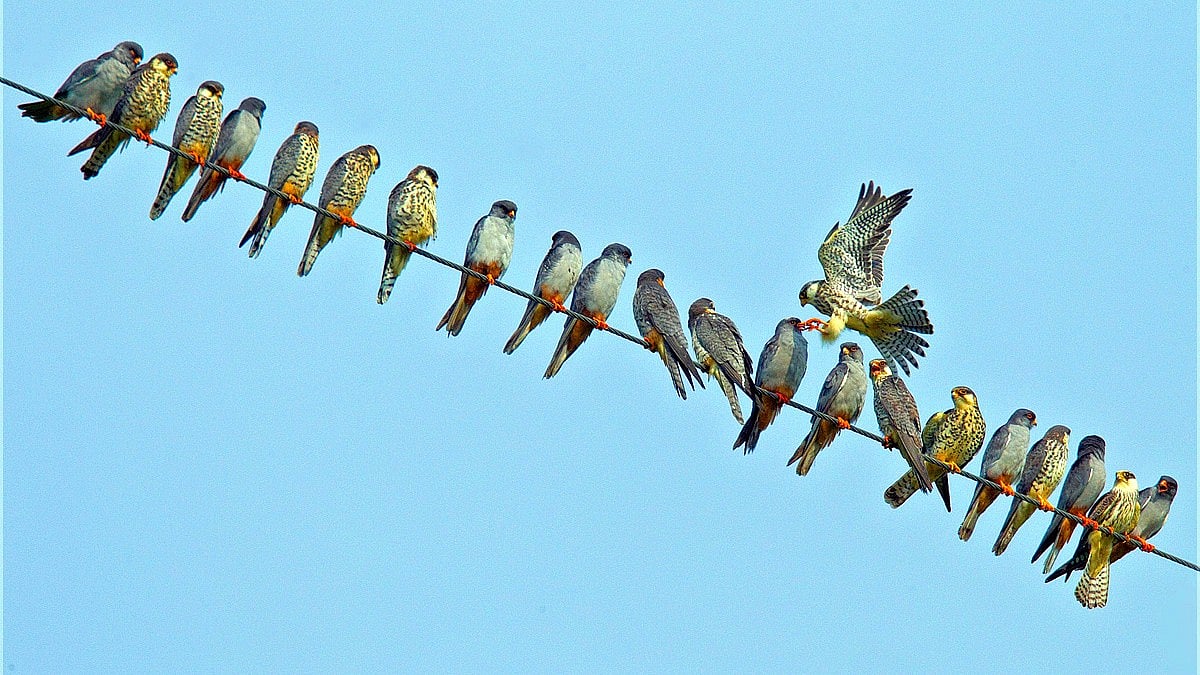Environment
A daring passage over India and beyond
Creating silent zones, spreading awareness among locals and students shows the power of community conservation

On 11 November, wildlife scientists tagged three Amur falcons — Apapang (an adult male), Alang (a young female) and Ahu (an adult female) — as part of the Manipur Amur Falcon Tracking Project (Phase 2) led by the Wildlife Institute of India.
Within days, Apapang, wearing the orange track on the satellite map, has surprised even veteran trackers. Barely 150 grams in weight, he soon launched into an extraordinary non-stop flight. In just 76 hours, he covered an astonishing 3,100 km, an aerial marathon that saw him slice across central India, glide past Gujarat, and out over the Arabian Sea.
The Arabian Sea poses an existential threat to these tiny birds. They have to fly non-stop for three days with no food and no stops, covering 6,000 km till they touch down in Somalia. The three tiny falcons are being tracked on the satellite map with both awe and worry by the scientists who are discovering new facets of the falcons’ extraordinary annual migration.
Astonishingly, the Amur falcon is not the fastest bird with its cruising speed estimated at a modest 45-50 km an hour. It is the small bird’s stamina and endurance, its capacity to fly over 3,000 km non-stop that has awed the scientific community.
Amur falcons breed in summer around the Amur lake, in Siberian Russia and China before flying south to India. They fly over the mighty Himalayan peaks to arrive in India’s Northeast where they stop to recover, feed and regain their strength before setting off for the African coast.
Their navigational skill has fascinated scientists as the falcons unerringly follow the same route year after year and arrive at their designated stopovers. They arrive in October-November every year in Manipur; in Nagaland they reach later in November and even later in Assam in December.
Published: undefined
All three states organise falcon festivals to greet the visitors. Eco-tourism is encouraged so that tourists can watch the birds and take pictures. However, no noise is allowed when the birds are resting and hence in mid-November, a silent zone has come up around three km of the Doyang lake in Nagaland's Wokha district.
Unusual and loud noises frightens the birds, forcing them to fly away before recouping their strength and stamina. The government directive imposing the temporary silent zone also warns that villages found to have harmed the birds or sheltered hunters could lose government grants and welfare schemes. The same order also bans the use of air guns in a state where every house often has more than one.
Nagaland has scripted an extraordinary community conservation success story. In 2012, conservationists were shocked to discover that tens of thousands of migrating falcons were being hunted and sold as meat. The birds returned unsuspecting each year, only to be trapped again.
A group of nature lovers, activists and conservationists reached out to local communities and schools to raise awareness about the falcons and their epic journey. Hunters were persuaded to give up the practice and train as bird guides instead. With eco-tourism camps and festivals providing new livelihoods, Nagaland earned the title 'falcon capital of the world' in 2013.
Published: undefined
Tourists now flock to witness the vast roosting flocks, with festivals featuring songs, dances, local food and exhibitions on the insect-eating raptors. Convincing a largely meat-eating, economically challenged population to give up an accessible source of protein was no small feat.
During the period when the number of falcons was dwindling, locusts grew in Africa and for years they raided and destroyed crops in Gujarat and Rajasthan. Even in Nagaland, termites and locusts — food for the falcons — wreaked havoc when the number of falcons dramatically dwindled. This was another reason why the birds should be allowed to continue on their journey, they were told.
The ‘news’ of the hunting of the falcons drew the attention of conservationists after a report was published in a newspaper in Delhi. Neha Sinha, writer and a nature lover, travelled to Nagaland to find out what was happening and was stunned by what she found. Soon, others joined her in building awareness about the extraordinary birds.
The government and the Wildlife Institute of India stepped in and started a community movement, helped by teachers and students, that is now acknowledged as a model for every other conservation effort in the world.
Published: undefined
Follow us on: Facebook, Twitter, Google News, Instagram
Join our official telegram channel (@nationalherald) and stay updated with the latest headlines
Published: undefined